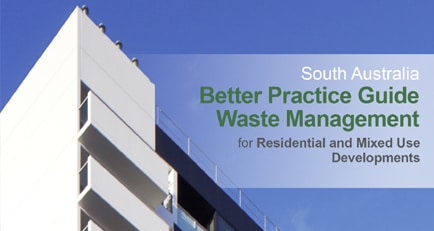
This Waste Management Better Practice Guide for Residential and Mixed Use Developments (the Guide) is intended to help organisations and businesses involved in planning and designing waste management systems for medium to high density and mixed use developments. It is hoped that the Guide will be a reference for all the stakeholders in this field in South Australia, encouraging a performance based approach to design better Waste Management Systems (WMS). The Guide presents design objectives, advice, and information to support better waste management outcomes. It is not prescriptive and it is not a design manual. In particular, building designers/developers, property owners, business operators, local councils and State Government agencies may refer to the Guide when: providing advice on expected requirements for a WMS proposing or designing a WMS for a development commenting on or assessing an application for development approval.
For the past decade South Australia has been a leader in waste management reform and resource recovery in Australia and is recognised as such internationally. South Australia is now more resource efficient, recovering and recycling more materials and reducing greenhouse gas emissions from landfill. South Australia’s successes have been solidly based on a source separation model. Waste is sorted into key waste streams (such as food organics, cardboard, paper and metals) by householders and businesses at their premises (at the source). This diverts useful materials away from landfill. Waste materials are then collected, generally by councils or waste contractors, for recycling, energy recovery or disposal.
New developments in South Australia need to accommodate this source separation during design activities. Changing urban form: More people in urban environments want to live and work near education, shops, entertainment, open space and public transport. Medium to high density and mixed use buildings are becoming a common feature in metropolitan Adelaide and in some regional centres. Conventional kerbside collection systems may be not be practical or cost-effective. Poor or inadequate waste management can quickly reduce the appeal of a site and lead to ongoing problems. Developers can support the needs of future owners and tenants in order to increase the attractiveness of the development, contributing to positive market perceptions. Setting agreed expectations of a well-designed and operated Waste Management System will: allow developers to meet requirements early in the design process and offer clarity to all parties promote waste minimisation, reuse and recycling define responsibility for waste transfer from the point of generation to centralised storage to point of removal contribute to the public realm as a safe and secure and attractive environment for pedestrian movement and social interaction.
To download information document click on PDF link in right column




